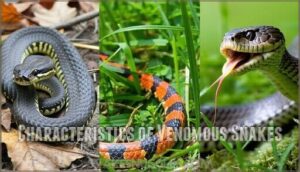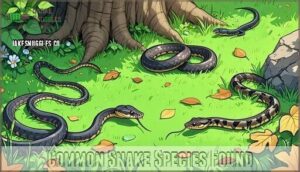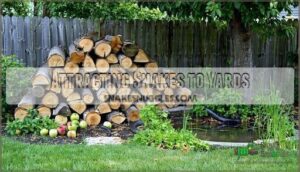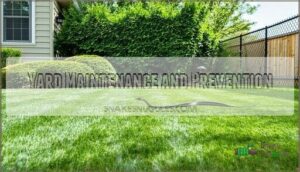This site is supported by our readers. We may earn a commission, at no cost to you, if you purchase through links.
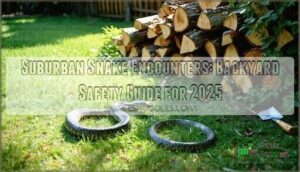
You’re most likely to spot them during warm months when they hunt for rodents, seek water sources, or find shelter in wood piles and dense vegetation.
Most backyard snakes are harmless and actually beneficial, controlling pest populations. However, you’ll want to distinguish between venomous species with triangular heads and heat-sensing pits versus non-venomous snakes with rounded heads.
Keep your yard tidy by removing debris, sealing gaps under structures, and eliminating standing water to make your property less attractive to both snakes and their prey.
Table Of Contents
- Key Takeaways
- Snake Encounters Rise
- Identifying Backyard Snakes
- Attracting Snakes to Yards
- Preventing Snake Encounters
- Handling Snake Encounters
- Frequently Asked Questions (FAQs)
- What does it mean when a snake appears in your yard?
- Why am I finding snakes in my yard?
- What attracts snakes to the yard?
- Who to call if there’s a snake in my backyard?
- Is it normal to have snakes in your yard?
- Why am I seeing so many garter snakes in my yard?
- How do I get rid of snakes in my backyard?
- What is the most common snake to find in your backyard?
- Are snakes active during certain weather conditions?
- What time of year do snakes hibernate?
- Conclusion
Key Takeaways
- You’re likely to encounter more snakes – Suburban snake encounters have increased 35% over the past decade, with one in three homeowners reporting annual sightings during warm months from April through September.
- Most backyard snakes are beneficial, not dangerous – You’ll typically find harmless species like garter snakes that control rodent populations, while venomous snakes can be identified by triangular heads and heat-sensing pits.
- Your yard attracts snakes through food, water, and shelter – They’re drawn to rodent populations, standing water sources, wood piles, dense vegetation, and debris that provide hunting grounds and hiding spots.
- You can prevent encounters through simple yard maintenance – Keep grass short, remove debris and wood piles, seal gaps under structures, eliminate standing water, and maintain distance if you spot one rather than attempting removal yourself.
Snake Encounters Rise
You’re encountering snakes in your backyard more often because suburban encounters have jumped by 20% in some metro areas since 2020.
One in three suburban homeowners now reports at least one snake sighting per year, with most encounters happening during warm months from April through September.
Increased Suburban Snake Sightings
If you’ve noticed more suburban snakes lately, you’re not alone.
Snake encounters in suburban areas have surged 35% over the past decade, with wildlife agencies documenting this sharp increase nationwide.
Animal control departments report a 20% annual rise in snake-related service calls since 2020, making backyard snakes a growing concern for homeowners seeking pet safety and children’s safety through proper snake identification and prevention methods.
This is partly due to altered activity patterns as they adapt.
Reasons for Rising Encounters
Urban sprawl drives snakes into neighborhoods as development fragments their natural habitats.
As suburban sprawl swallows wild spaces, displaced snakes slither closer to home.
Climate change extends snake activity periods, while suburban yards attract rodents that snakes hunt.
You’ll notice more backyard snakes because habitat fragmentation forces them closer to homes.
Reduced predators and prey abundance create perfect conditions for suburban wildlife encounters.
Peak Snake Activity Periods
You’ll notice snakes become most active during warm weather months from April through September, when temperatures rise above 60°F.
Seasonal patterns show breeding seasons in spring trigger increased movement, while prey availability peaks during summer months.
Hibernation habits keep snakes dormant in winter, making professional snake removal and prevention most effective during active periods when backyard wildlife encounters surge.
Identifying Backyard Snakes
When you spot a snake in your backyard, proper identification helps you determine if it’s dangerous or harmless.
Most suburban snakes are non-venomous species that actually benefit your yard by controlling rodent populations.
Characteristics of Venomous Snakes
Recognizing venomous snakes can save your life.
These dangerous species possess specific features that set them apart from harmless varieties.
Key identifying characteristics include:
- Venom Delivery Systems – Fangs appear hollow or grooved, designed for injecting neurotoxins or hemotoxins into prey
- Pit Vipers – Heat-sensing pits between eyes and nostrils help detect warm-blooded animals
- Coral Snakes – Bright red, yellow, and black bands with red touching yellow indicate danger
Understanding these traits helps you make quick decisions about snake removal and snake safety during backyard encounters.
Characteristics of Non-Venomous Snakes
Unlike their venomous cousins, nonvenomous snakes display round pupils and lack heat-sensing pits.
Their scales pattern varies widely, from solid colors to intricate designs.
These snake species maintain diverse diet variety, consuming rodents, insects, and eggs.
Their behavior traits include defensive posturing when threatened.
Understanding snake anatomy helps distinguish between dangerous and harmless varieties, supporting effective snake prevention and snake control efforts in suburban habitats.
Common Snake Species Found
Five common snake species you’ll encounter include the Eastern Garter Snake and Eastern Rat Snake among nonvenomous varieties.
For Copperhead ID, look for hourglass patterns and heat-sensing pits.
Water Moccasin and Coral Snake represent dangerous species requiring immediate snake control measures.
Garden snakes like Dekay’s Brownsnake are harmless, making proper snake species identification essential for effective snake prevention.
Attracting Snakes to Yards
Understanding what attracts snakes to your property helps you make informed decisions about yard management and safety precautions.
Common attractants include abundant food sources like rodents, accessible shelter areas such as wood piles, and reliable water sources that create ideal snake habitats, which are often linked to abundant resources.
Food Sources for Snakes
Understanding what attracts snakes helps you manage potential wildlife encounters in your backyard.
These reptiles follow their food sources, making certain yards more appealing than others.
Primary food sources that draw snakes include:
- Rodent populations – Mice and rats under decks or sheds provide up to 85% of suburban snake diets
- Bird eggs and nestlings in low shrubs become easy targets for rat snakes and garden snakes
- Amphibian presence around water features attracts garter snakes seeking frogs and salamanders
- Insect abundance in mulched areas supports smaller snake species hunting slugs and earthworms
- Pet food spills create indirect attraction by supporting rodent populations that snakes hunt
Effective pest control reduces these food sources naturally.
Shelter and Hiding Spots
Snakes seek shelter in rock piles, woodpiles, sheds, and dense vegetation around your property.
Under decks provide perfect hiding spots where reptiles feel secure from predators.
These areas offer protection and regulate temperature, making your yard attractive to various snake species.
Understanding snake behavior helps prevent unwanted wildlife encounters and reduces potential snake bites through better pest control.
Providing proper hiding spaces can reduce their stress.
Moisture and Water Sources
Water sources draw snakes like magnets.
Snakes follow water like a compass needle points north.
Standing water in bird baths, leaky faucets, and irrigation systems create perfect drinking spots. Ponds and streams naturally attract reptiles seeking hydration.
Even small puddles from sprinkler systems can bring snakes closer to your home.
Remove these moisture sources to reduce snake encounters and potential snake bites, it’s a key step to minimize snake presence.
Preventing Snake Encounters
You can prevent most snake encounters by maintaining your yard and removing what attracts them.
Simple changes like clearing debris, sealing gaps, and reducing hiding spots make your property less appealing to snakes.
Yard Maintenance and Prevention
Regular maintenance keeps snakes away from your property. Mowing practices like cutting grass short eliminate hiding spots. Plant choices matter – avoid dense shrubs near foundations.
Remove predator attractants like bird feeders that draw rodents. Consider fencing options with mesh buried underground. Chemical repellents offer temporary solutions.
Basic reptile identification helps determine threats. Professional reptile removal beats risky DIY approaches, unlike automotive repairs where vehicle maintenance skills transfer easily.
Encouraging snakes as natural pest control can reduce reliance on chemicals. Regular maintenance keeps snakes away and is a form of natural control. It also involves professional reptile removal for safety.
Removing Debris and Clutter
Cluttered yards offer perfect hiding spots that snakes find irresistible. Leaf removal eliminates cover where reptiles rest during daylight hours.
Clear woodpiles, rock piles, and compost heaps regularly to reduce shelter options. Trim overgrown vegetation that provides corridors for movement.
This DIY approach requires basic automotive advice-level maintenance skills for effective reptile removal. Consider using the right leaf removal to expedite this process.
- Woodpiles become snake hotels – Stack firewood away from your home’s foundation
- Leaf piles create cozy hideouts – Rake and dispose of fallen leaves promptly
- Rock gardens harbor reptiles – Remove loose stone collections near walkways
- Compost bins attract prey – Keep composting areas tidy and enclosed
- Tall grass provides highways – Maintain short lawn height for reptile identification
Sealing Entry Points and Gaps
Foundation cracks as small as a quarter-inch welcome unwanted slithering visitors into your home.
Seal gaps around pipe openings with weather-resistant caulk and install vent screens on crawlspace entries. Add door sweeps to exterior doors and secure window wells with hardware cloth.
For sealing these cracks, consider using a quality crack sealant.
Like vehicle maintenance requires regular automotive troubleshooting, home sealing needs annual inspections for effective car repairs-style prevention, ensuring a quality seal.
Handling Snake Encounters
When you encounter a snake in your backyard, stay calm and keep your distance to avoid startling the animal.
Most snake encounters can be resolved safely by giving the snake space to leave on its own, but knowing when to call professionals is essential for your safety.
Staying Safe Around Snakes
When you spot a snake, freeze immediately and back away slowly.
Never attempt to catch or kill it yourself. Keep pets and children at a safe distance while you assess the situation.
If you’re in your Chevy Suburban or SUV, stay inside until the snake moves away.
Consult automotive community forums for snake-proofing gear recommendations and professional relocation options.
Identifying Venomous and Non-Venomous
You can distinguish dangerous snakes from harmless ones by checking key features.
Venomous pit vipers have triangular heads, vertical pupils, and heat-sensing pits between their eyes and nostrils. Non-venomous snakes display round pupils, narrow heads, and smoother body profiles.
Snake markings matter too—bold bands or hourglass patterns often signal venom.
For safe handling, consider using snake hooks and tongs.
How to Handle a Snake Encounter
Stay calm and back away slowly from any snake you encounter.
Don’t make sudden movements or attempt to kill the snake.
Most bites happen when people try to handle or harm snakes.
Keep children and pets indoors while the snake moves on naturally.
If bitten, seek immediate medical attention and remember basic Snakebite First Aid principles.
Even in your Chevy Suburban driveway, give snakes space to retreat safely, following the principle to stay calm.
When to Call a Professional
Knowing when you can’t handle a situation alone keeps you and your family safe.
Some snake encounters require expert snake removal services immediately.
Call professionals when:
- Venom identification needed – You can’t positively identify if the snake is venomous
- Children/pet safety concerns – Snake appears near play areas or pet zones
- Emergency snake situation – Multiple snakes, aggressive behavior, or indoor encounters
Snake relocation services have proper tools and expertise.
Correctly identifying snakes using available identification tools is vital for safety.
Don’t risk it – professional help prevents the 50% bite rate from DIY removal attempts.
Frequently Asked Questions (FAQs)
What does it mean when a snake appears in your yard?
When a serpentine visitor graces your property, it’s typically seeking food, water, or shelter. You’re likely dealing with a harmless species hunting rodents, which actually benefits your yard’s ecosystem naturally.
Why am I finding snakes in my yard?
You’re finding snakes because your yard offers food, water, shelter, or hunting grounds. They’re attracted to rodents, bird eggs, cool hiding spots, and water sources like sprinklers or pet bowls.
What attracts snakes to the yard?
Picture your garden hose left running overnight—you’ve created a snake magnet.
Food sources like rodents, insects, and bird eggs attract snakes.
Water sources, shelter spots, and overgrown vegetation also draw them to your yard, making it a haven that can be considered a snake attraction.
Who to call if there’s a snake in my backyard?
Contact local animal control, wildlife removal services, or your city’s non-emergency line. Many areas offer free snake removal. Don’t attempt removal yourself—professionals handle venomous and non-venomous species safely.
Is it normal to have snakes in your yard?
You’re not alone in this slithery situation.
It’s surprisingly normal to find snakes in your yard, with one in three suburban homeowners spotting them annually.
Increased development pushes snakes into residential areas, making backyard encounters common, especially during warmer months, which can be a surprisingly normal occurrence.
Why am I seeing so many garter snakes in my yard?
You’re likely seeing more garter snakes because they’re attracted to food sources like insects, small rodents, and moisture in your yard.
They’re also seeking shelter and may be displaced from nearby habitat changes.
How do I get rid of snakes in my backyard?
Remove food sources like pet food and birdseed, eliminate water sources, keep grass short, seal gaps under structures, and use snake repellent sprays around your property’s perimeter.
What is the most common snake to find in your backyard?
Garter snakes are the most common backyard visitors you’ll encounter.
These harmless, non-venomous snakes with distinctive stripes prefer gardens and yards because they’re hunting for insects, worms, and small rodents that damage your plants. These harmless snakes.
Are snakes active during certain weather conditions?
Yes, snakes are most active during warm weather when temperatures range between 70-90°F.
They’re typically more active during spring and summer months, becoming sluggish in cold weather and entering hibernation-like states during winter.
What time of year do snakes hibernate?
Most snakes enter brumation (hibernation) from October through March when temperatures consistently drop below 50°F.
You’ll notice decreased snake activity as cold weather approaches, with snakes seeking underground dens or sheltered spots to survive winter’s chill.
Conclusion
Surprisingly, your suburban snake encounters backyard experiences don’t have to end in panic.
Understanding snake behavior patterns helps you coexist peacefully with these beneficial pest controllers.
By maintaining clean yards, removing debris, and sealing entry points, you’ll reduce unwanted visits while protecting your family.
Remember that most snakes you’ll encounter are harmless neighbors simply seeking food and shelter in your expanding suburban landscape, and can be considered beneficial pest controllers.

